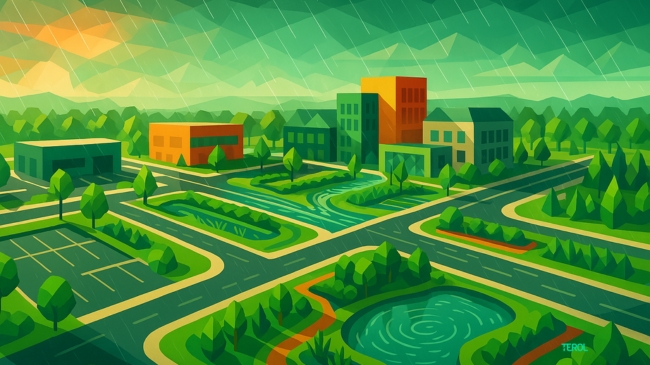Stormwater management is one of the most important parts of civil engineering, even if it doesn’t always get a lot of attention. It’s not the most exciting part of a project, but if it goes wrong, you could end up with big problems like floods, sinkholes, and unhappy city inspectors.
If you want to build better projects that work with nature, not against it, you’re in the right place. In this post, we’ll look at the best ways to add smart stormwater solutions into your designs. Let’s jump in!
Why stormwater management matters
When rain falls on natural ground like grass or soil, it sinks into the earth. But when it hits roads, parking lots, and buildings, it can’t soak in. Instead, the water runs off, picking up dirt, trash, oil, and other pollution along the way. If we don’t control where this water goes, it can cause big problems like flooded streets, damaged parks, and dirty rivers.

Good stormwater management helps protect nature, saves cities a lot of money on repairs, and keeps our projects safe and successful.
1. Start early, start smart
Stormwater management isn’t something you should think about at the last minute. It needs to be a key part of your project from the very beginning. Waiting too long to plan for stormwater can lead to big problems like flooding, soil erosion, and expensive changes to your design later on.
Think of stormwater like an important guest at a party. If you don’t plan where they’ll sit, eat, and hang out, they might wander into places they shouldn’t, causing a mess. The same thing happens with rainwater. If you don’t plan for where the water should go, it will flow wherever it wants, and that usually means trouble.
The best way to avoid this is to plan for stormwater early on. It’s a good idea to talk to a hydrology expert as soon as you can. These experts understand how water behaves, and they can help you figure out the best way to manage it.
Before you even start designing things like parking lots, roads, or buildings, take some time to figure out how rainwater will move around the site. Draw a rough map of the area and think about these questions:
- Where will the rainwater collect?
- How fast will the water flow across the site?
- What can you do to slow it down and help it soak into the ground?
Planning early also gives you the chance to use natural, cost-effective methods to manage water, like grassy areas, rain gardens, and swales. These solutions are often cheaper and easier to maintain than digging up pipes later on.

Design Tip:
Before you start planning parking lots or roads, sketch out how stormwater will move across the site. This will help you stay organized and ensure that the water doesn’t cause any problems later.
Bonus Tip:
Planning for stormwater from the start can save you a lot of money. Making changes later in the process can be very costly and can delay your project. Getting the stormwater plan right early means you’ll have fewer surprises as the project moves forward.
2. Let’s talk about green infrastructure
Pipes and concrete drains do the job when it comes to managing stormwater, but today we have more creative and nature-friendly solutions. Green infrastructure uses natural elements like plants, soil, and trees to help manage rainwater in a way that’s both effective and visually appealing.
Instead of just letting water run off into drains, green infrastructure works with nature to capture, slow down, and clean rainwater before it floods streets or causes pollution. Plus, it makes any area look greener and more pleasant.
Here are a few green infrastructure options that civil engineers are using more and more:
Rain Gardens: These are small, designed areas filled with plants and soil that catch rainwater and let it soak into the ground. They help reduce runoff and improve water quality by filtering out pollutants before they reach other parts of the environment. On top of that, they add beauty and biodiversity to any area.
Bioswales: These are shallow, planted ditches that slow down and clean rainwater as it moves. As water flows through the bioswale, it gets filtered by the plants and soil, removing dirt, oil, and other pollutants. This helps to prevent pollution from flowing into streams, rivers, and storm drains.
Permeable Pavement: Unlike regular pavement, permeable pavement is designed to allow water to pass through it and soak into the ground beneath. This prevents rainwater from running off into storm drains, which can cause flooding. Permeable pavement is used for driveways, walkways, and parking lots, helping to keep areas dry and reduce the burden on drainage systems.
Design Tip:
It’s a good idea to mix green infrastructure with more traditional methods like pipes and culverts. Nature is great at managing water, but in some cases, you still need a pipe to make sure everything flows as it should. Combining both types of systems gives you a balanced, effective stormwater solution.
3. Detention vs retention: Know the difference
Let’s clear up a common mix-up!
Detention ponds are like short-term parking for rainwater. After a big storm, the water collects in the pond and is slowly released over time. These ponds are usually dry most of the time and only fill up when it rains a lot. They help prevent flooding by slowing down how fast water leaves a site.
Retention ponds are like long-term parking. They hold water all the time, not just during storms. When it rains, the pond fills up more, but it always keeps some water in it. Retention ponds not only manage stormwater but also make nice homes for birds, frogs, and plants.
Each type has its job, and choosing the right one depends on what the project needs.
Design Tip:
Go with a detention pond if your main goal is to slow down rainwater and stop flooding. It’s simple, effective, and great for areas where you just need quick water control.
Choose a retention pond if you want a little extra. They can add beauty to a site, create spaces for wildlife, and even make a property more valuable. Clients love having a pretty pond to show off!
Bonus Tip:
Sometimes you can mix both! A detention pond with a small permanent pool (kind of like a mini retention pond) gives you the best of both worlds—good stormwater control and a nice view.
4. Design for the 100-year storm (Not just a spring shower)
With climate change, weather patterns are changing, and we’re seeing storms that are stronger and more unpredictable. A flood that used to happen once every 10 years might now happen every few years. So, we can’t just design for the average storm anymore—we need to plan for the worst-case scenario.
Can you imagine? yesterday’s “10-year flood” might be tomorrow’s regular afternoon storm. If you only design for small, common storms, you could end up with major flooding when something bigger hits. This is where planning for a “100-year storm” comes in. A 100-year storm doesn’t happen every year—it’s an extreme event that has a 1% chance of happening each year. But because extreme weather is becoming more common, we need to be prepared for it.
By designing for the worst storm, you’re future-proofing your project. It may seem like overkill, but it’s the smart choice. When your system can handle the big storms, your project will be safer and more resilient. You’ll also save money on repairs and updates down the line.
Design Tip:
Use storm models that predict extreme weather, not just the average rainstorm. This way, your system will be able to handle heavy rainfall or unexpected events. Planning for the “big one” will make sure that your project and the surrounding area can handle whatever nature throws its way.
5. Maintenance, maintenance, maintenance
You could design the best stormwater management system in the world, but if nobody takes care of it, it won’t work for long. Over time, drains, filters, and ponds can get clogged with leaves, dirt, and debris. If they aren’t cleaned out regularly, they’ll stop doing their job—and that can lead to floods, pollution, and other problems.
That’s why maintenance is just as important as design. Without a good maintenance plan, your stormwater system won’t stay efficient, and you’ll end up facing costly repairs.
Design Tip:
When designing your stormwater management system, choose options that are easy to maintain. Simple systems that don’t need a lot of work are better in the long run. Also, make sure to include a clear maintenance plan in your project documents. That way, the people in charge will know exactly what needs to be done and when.
Bonus points: If you design systems that are easy and inexpensive to maintain—like filters and drains that can be cleaned out quickly—you’ll save time, money, and hassle in the future.
6. Make friends with local rules
When it comes to stormwater management, every city, county, and state has its own set of rules. Some areas have relaxed regulations, while others are pretty strict. No matter where you’re working, it’s important to understand what’s required before you start your project.
If you don’t follow the local stormwater regulations, you could face delays, fines, or worse—having to redo parts of your project. So, it’s a good idea to get familiar with the local rules early on. The sooner you understand what’s expected, the smoother the project will go.
Design Tip:
Get in touch with the local permitting agencies early in the planning process. Review their stormwater management ordinances and make sure your design meets all the requirements. This will keep your project on track and help you avoid any last-minute issues. Staying compliant is key to moving your project forward without delays or unexpected fines.
7. Show it off
Clients and communities love seeing sustainable features in action. So why hide all those awesome stormwater solutions you’ve worked hard to design? Swales, rain gardens, and permeable pavements aren’t just practical—they can also be beautiful and educational. Instead of hiding them behind fences or out of sight, show them off!
By highlighting your stormwater features, you’re not only making your project more attractive, but you’re also helping people understand how smart design can work with nature. People love to see solutions that benefit the environment and make a place look nicer at the same time. Plus, when stormwater features are visible, they become a talking point for your clients, employees, and the community.
Design Tip:
Use landscaping, signage, and pathways to highlight your stormwater features. For example, a rain garden can be surrounded by walking paths, or a bioswale can be turned into a green space with benches and signage explaining how it helps manage rainwater. When you design stormwater solutions to be visible and accessible, you turn them into amenities that people will love and brag about.
Wrapping it up: Stormwater management is the real MVP
If you want your projects to be safe, smart, and sustainable, stormwater management needs to be part of the plan from the start. It’s not just a small detail—it’s a key part of making sure your project is built to last. By thinking ahead, working with nature, and following best practices, you’ll avoid big problems like flooding and water damage. Plus, you’ll create projects that are greener, more attractive, and better for the environment.
Stormwater management isn’t just about managing rainwater—it’s about being smart with your design, protecting the future, and adding value to your projects. It’s the real MVP (Most Valuable Player) in civil engineering!

Ready to be a stormwater superhero?
We’d love to hear from you! Drop a comment below with your favorite stormwater management tip or a challenge you’ve faced in a project. Your experience might just help someone else solve their stormwater puzzle. Let’s keep the conversation flowing!


